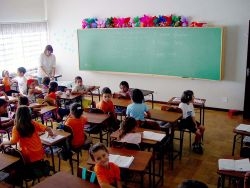Halifax Media Co-op
News from Nova Scotia's Grassroots
Class Size Matters
It’s official: class sizes will go up in the Halifax Regional School Board next year.
Average class sizes in elementary will rise from 23.5 to 25.2 students, while in middle school the average will go from 24.2 students per class to 26.7, says a recent Chronicle-Herald report.
Numbers for high school classes were unavailable, the story says, because of the more complex nature of students’ course schedules; but it’s safe to assume the trend will be the same.
Save for a few letters to the editor, however, it would seem that Nova Scotians don’t view larger classes as a big deal. If you can teach 24 kids in a classroom, why not 26?
To start, note that the numbers being given as “average” class size are not too meaningful. As outgoing Nova Scotia Teachers' Union president Alexis Allen has noted, the school board’s averages seem to be calculated including not just classroom teachers, but school administrators, guidance counsellors, and a smattering of other non-classroom staff.*
These people of course do invaluable work in the school system, but they shouldn’t be taken into account when trying to get an accurate picture of classrooms in Nova Scotia.
Second, consider that average class sizes often aren’t a very meaningful statistic in practice. In my six years of teaching (high school) I’ve had classes of 32 to 36 students on several occasions. With numbers like those in a classroom every day, it’s little comfort knowing that the average provincial class size may be smaller.
In elementary school, some primary classes are expected to hit 29 students next year. Higher teacher-student ratios of course mean less face time for each student – less opportunity for the teacher to give each kid the attention he or she deserves. As a colleague of mine wrote recently in a letter to his MLA: “Have you ever seen a room with 26 four- and five-year-olds and one adult?”
Some educational researchers have put forward the argument that class size actually doesn’t matter that much. Paul W. Bennett, a private educational consultant and former headmaster of the Halifax Grammar School and Lower Canada College, recently published pieces in the Chronicle-Herald and on his blog arguing that class sizes effectively don’t affect student achievement past the first few grades. Bennett argues that the “most authoritative study” on the topic was put out by the right-wing C.D. Howe Institute in 2005.
The problem is that the main measure of ‘student achievement’ in these studies is standardized testing.
Without even delving into the controversy over the (lack of) merit of basing school programs around these tests, one can easily argue that they are a poor measure of success when considering class sizes.
Neither I nor any of my colleagues entered the teaching profession because we wanted to improve kids’ scores on standardized tests. We became teachers because we wanted to interact with kids on a daily basis, help them realize their full personal potential, and get them excited about learning about the world around them.
Larger classes mean less student-teacher individual face time – period. Each additional student crammed into my classroom means I have less time to get to know each student personally, to tailor lessons to their needs, and to help them when they need personal or academic help.
Parents want their kids to get good grades at school. But they also want school to be a safe place where adults are in charge. With more kids per teacher at school, there are fewer adults to deal with bullying and harassment; to call out racism, sexism, and homophobia; to volunteer for extra-curricular activities; and do all the things that make school a more human place.
(Incidentally, Paul Bennett didn’t answer when I asked him what class sizes are like at the two private schools where he was headmaster.)
On Wednesday 3 of the 10 members of the HRSB voted against the board’s budget. Board member David Cameron lamented the fact that the HRSB was receiving the lowest per-student funding in the province.
But P-12 education funding shouldn’t be an issue looked at in isolation. We’re told we just can’t afford to fund our schools properly anymore, along with other public services. These are times of austerity, and we all need to do our part to bring the province Back to Balance(TM).
Never mind the fact that Nova Scotia’s economy has grown steadily for decades while inequality has risen, and corporate tax rates have been slashed under successive Liberal and Conservative federal governments, costing public services billions of dollars in lost revenues with negligible effects on job creation.
(Yes, education funding is provincial, but one third of Nova Scotia’s budget comes from federal tax revenues.)
The debate shouldn’t be about whether we fund public healthcare or education, as the Herald’s Marilla Stephenson suggested in a column recently.
We’re living in one of the wealthiest societies in history. We need to push our governments away from the obsession with “deficit-slaying” and bring some of that wealth back into the hands of the people who created it. That means funding adequate public services.
I’d teach my students about this – but it’s hard when there’s 36 of them.
*Allen said this on the radio, though I can't find a written source on-line.
The site for the Halifax local of The Media Co-op has been archived and will no longer be updated. Please visit the main Media Co-op website to learn more about the organization.



